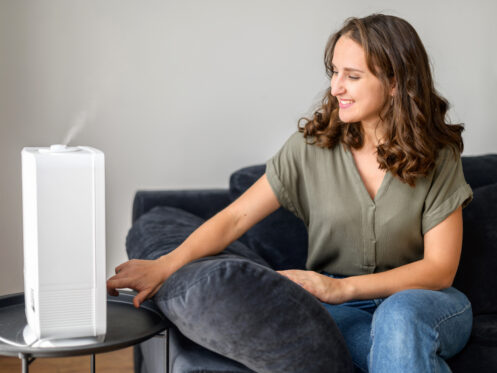During the winter months, having a well-functioning heating system is an absolute necessity to keep your family and home safe from the cold weather. Unfortunately, all the indoor heating can lead to excessive dryness in your air. Understanding what causes that dryness can help you better understand how to remedy it.
What Is Optimal Indoor Humidity?
The humidity level inside a home is known as relative indoor humidity. The ideal range for indoor humidity is between 30 and 50%. If humidity drops too low, it can dry out your skin and lead to sinus irritation. If your indoor humidity level is too high, it can promote mold and mildew growth.
What Happens When Indoor Humidity Is Too Low?
When relative indoor humidity drops below 30%, it can lead to damage to your home and your health. When it comes to physical effects, you can experience dry and itchy eyes, dry skin, sinus irritation, and illnesses spreading more readily. When it comes to your home, low humidity can lead to excessive static electricity that can damage sensitive electronics. It can also excessively dry out wood items, like your flooring and furniture. When wood dries out too much, it can shrink and lead to damage.
What Causes Dry Indoor Air?
During the winter months, the air seems to be much drier than you’ll find in the summertime. This is because cold air contains very few water molecules. It’s actually very difficult for cold air to absorb a sufficient amount of moisture due to having a very low maximum water pressure vapor. When you heat up your home artificially with your furnace or boiler, your indoor air will get even drier. This is because artificial heating will remove water vapors from your indoor air.
How to Increase Indoor Humidity?
Increasing the relative humidity level inside your home can be done in numerous ways. One of the most effective is to invest in a whole-home humidification system. This introduces water back into the air to bring your indoor air up to your desired relative humidity setting. There are three main types of whole-home humidifiers, which are bypass, power, and steam.
Bypass Humidifiers
One of the most common and less invasive humidifiers is the bypass. This relies on the natural heat of the furnace to evaporate water to increase the humidity level. This type of humidifier gets installed directly inside the return plenum. It contains a panel that houses water.
When the humidity level needs to increase in your home, water is introduced into the panel. As your furnace’s blower passes air over the panel, its heat will cause evaporation. A bypass humidifier will only work when your furnace is running because of its dependence on the blower fan.
Power Humidifiers
A power humidifier works much like a bypass humidifier with one major exception. This type of humidifier has its own blower fan. This fan helps speed up the evaporation of moisture into the air to increase your home’s humidity level. While this fan can certainly help circulate air, it’s not powerful enough to move the more humid air out of your ducting and into the various rooms of your home. Therefore, for a power humidifier to work, your furnace’s blower fan will still need to be running to fully circulate the more humid air.
Steam Humidifiers
Unlike bypass and power humidifiers, steam humidifiers don’t rely on the natural heat from the air to evaporate moisture. Rather, they have an internal heating element that sits under a small pool of water. When you need to increase the humidity level in your home, the heating element turns on and heats up the water. As it turns into steam, your furnace’s blower fan will circulate the steam to the various rooms of your home.
What Type of Whole-Home Humidifier Should You Get?
All types of whole-home humidifiers excel in different environments. Probably one of the most notable factors for determining which one you should get is the size of your home. Small homes can work just fine with a simple bypass humidifier. However, larger homes will likely need to invest in steam or power humidifiers because they offer additional power to circulate the humid air. It’s very common for larger homes to need multiple humidifiers to achieve their desired relative indoor humidity level.
Another factor to consider is the location of your hot water heater. Hot water is going to evaporate much more readily than cold water, which is why it’s best to supply both the bypass and power humidifiers with hot water. However, the location of your return plenum and hot water heater will determine how functional this would be. If there’s not a hot water supply close, it’s best to invest in a steam humidifier that can better warm the water for evaporation into your indoor air.
Maintenance is something that every humidifier is going to need. However, steam humidifiers tend to develop more mineral deposits due to the natural way that they work. Many people with steam air humidifiers are familiar with this buildup that can lead to mold and mildew growth. If you opt to get a steam humidifier, it’s important to be mindful of regular maintenance to prevent this unwanted mold growth.
Getting a Smart Thermostat
When you integrate a whole-home humidifier into your HVAC system, it’s best to upgrade your existing thermostat. You’ll need one that will allow you to control the relative indoor humidity level. Most smart thermostats have this capability and give you the added advantage of being able to better control your indoor humidity level from the convenience of your smartphone or tablet. All you have to do is simply set your desired indoor humidity level and your humidifier will take care of getting your home to that level.
The Many Benefits of Getting a Whole-Home Humidifier
Making the decision to invest in a whole-home humidifier can come along with many great benefits. One of the most obvious is that it allows you to automatically control the humidity level inside your home. You won’t have to worry about trying to optimize multiple portable humidifiers. You can easily set your optimal relative humidity level and let your whole-home humidifier take care of getting it there.
Another advantage of getting a whole-home humidifier is that it can allow you to enjoy more comfortable air. You can avoid the many health issues associated with dry air, like sinus irritations and dry skin. Furthermore, your home’s wood components won’t shrink due to overly dry air.
When humidity levels remain optimal inside your home during the winter months, it can help reduce the need to set your thermostat high. Air that has more moisture is able to retain more heat. So, when you have optimal moisture levels in your air, it will retain more of the heat that your heating system produces so you don’t have to keep your thermostat settings so high.
Reliable Whole-Home Humidifier Service
Blue Best Plumbing, Heating, Air, & Generators offers reliable whole-home humidifier services for the Bountiful, UT area. We can also help with all your plumbing, air conditioning, heating, commercial HVAC, ductwork, and indoor air quality needs. Simply call our friendly office staff today to book your next service consultation.








